Instructions for Side by Side Printing
- Print the notecards
- Fold each page in half along the solid vertical line
- Cut out the notecards by cutting along each horizontal dotted line
- Optional: Glue, tape or staple the ends of each notecard together
Exam 3 questions
front 1 Ouabain, an inhibitor of the Sodium Potassium Pump, is a _________ that inhibits the pump by binding to the _______ part of the transporter. | back 1 cardiac glycoside, extracellular |
front 2 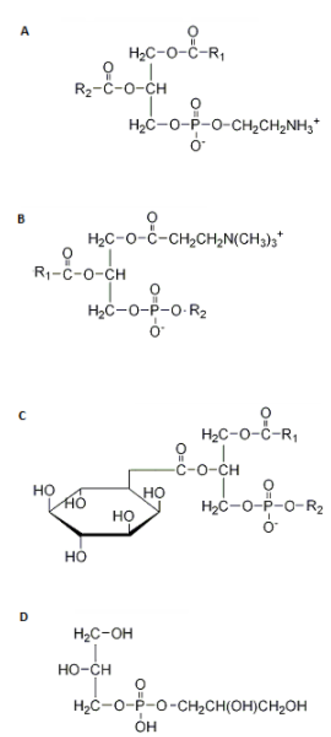 Which of these structures correctly represents a glycerophospholipid? | back 2 Structure A |
front 3 The convention for drawing the structure of disaccharides is to draw the _______ end on the left, and the ______ end on the right. | back 3 non-reducing, reducing |
front 4 All of the following is (are) found as covalently attached anchors in lipid-linked proteins, EXCEPT: A) glycosylphosphatidyl inositol B) cholesterol and other sterols C) isoprenes D) All of the above are found as covalently attached anchors in lipid-linked proteins. E) fatty acids | back 4 cholesterol and other sterols |
front 5 Peptidoglycans are primarily found in | back 5 Bacterial cell walls |
front 6 Which of the following is true about membrane glycoproteins? A) They increase the hydrophobicity of the membrane. B) They function primarily in energy storage. C)They are located exclusively on the inner leaflet of the plasma membrane. D)They serve as solute transporters in the membrane. E)They play a key role in cell recognition and communication. | back 6 They play a key role in cell recognition and communication. |
front 7 What describes why plant oils are generally healthier for human consumption than animal fats? | back 7 Plant oils usually contain more unsaturated fatty acids than animal fats |
front 8 Lactose is made up of which of the following monosaccharides? | back 8 Glucose and Fructose |
front 9 Which of the following segments of the integral membrane protein glycophorin most likely contains the transmembrane alpha helix? A) SQTNDTHKRDTYAATPRA B) LSTTEVAMHTTTSSSVSKSY C) ITLIIFVMAILVIAFMILLI D) VSEISVRTVYPPEEETGE E) YGIRRLIKKSPSDVKPLP | back 9 C) ITLIIFVMAILVIAFMILLI |
front 10 What correctly describes monosaccharide isomers? | back 10 Formation of a hemiacetal, or a hemiketal, creates a new chiral center. |
front 11 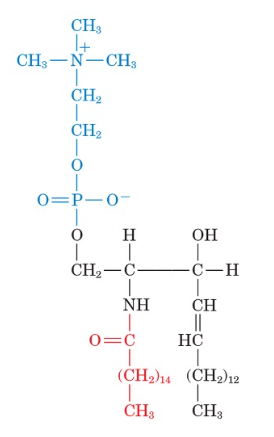 Identify the compound | back 11 sphingomylelin |
front 12 Which of the following are used for energy storage? A) Fatty Acids B) Glycerophospholipds C) Cholesterol D) Sphingolipids E)Triacylglycerols | back 12 Triacylglycerols |
front 13 How many reducing ends does glycogen have? | back 13 One |
front 14 What can form a cyclic hemiketal? | back 14 Fructose |
front 15 What does transverse asymmetry mean in the context of membrane structure? | back 15 The composition of the inner leaflet and outer leaflet of the bilayer are different |
front 16 Which of the following pairs are epimers? | back 16 glucose and mannose |
front 17 AcrB is a(n) ____ that transport drugs out of the cell ____ their concentration gradient using energy from protons entering the cell ____ their concentration gradient. | back 17 secondary active transporter; up; down |
front 18 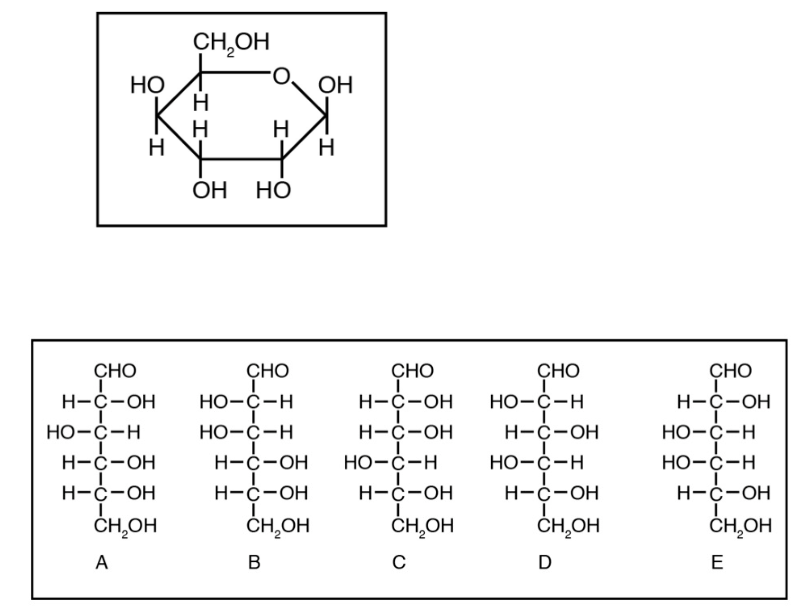 Which Fisher Projection represents the same monosaccharide as the Haworth Projection? | back 18 C |
front 19 What is the position of the hydroxyls on the chiral carbons of D-fructose in the linear structure (Fischer projection)? | back 19 Left, right, right |
front 20 Amide-linked ____ anchors are covalently attached to the ____ of ____ residues on proteins. | back 20 myristoyl; alpha amino group; glycine |
front 21 The sodium potassium pump transports 3 Na+ ions ___ and 2 K+ ions ___ for every 1 molecule of ATP hydrolyzed. | back 21 out of the cell; into the cell |
front 22 Which of the following is an example of a monosaccharide?Correct answer: A)Galactose B) Sucrose C) Maltose D)Amylose E)Lactose | back 22 A)Galactose |
front 23 Which of the following statement about cell membrane states is TRUE? A) Lipid rafts phase separate in single monolayers in the liquid-ordered state. B) The liquid-ordered state predominates below the melting temperature of a membrane. C) The solid-ordered state predominates above the melting temperature of a membrane. D)Thioether linked proteins are found in the liquid-ordered state. E) The liquid-ordered state can only be made up of lipids with unsaturated fatty acid tails. | back 23 A) Lipid rafts phase separate in single monolayers in the liquid-ordered state. |
front 24 ____ and ____ increase melting temperatures of fatty acids and lipids that contain them | back 24 Saturation; longer acyl chains |
front 25 What polysaccharide is a branched polymer? | back 25 amylopectin |
front 26 Starch is a mixture of | back 26 amylose and amylopectin |
front 27 The monosaccharide used to make glycogen is _____, while the monosaccharide used to make RNA is _____ and DNA is _____. | back 27 glucose; ribose; deoxyribose |
front 28 Peripheral membrane proteins are | back 28 Bound to integral membrane proteins or polar head groups of lipids |
front 29 O-linked oligosaccharides are important on glycoproteins in order to | back 29 lift the protein functional domains above the glycocalyx. |
front 30 What type of glycosidic bond is found in maltose? | back 30 α(1→4) |
front 31 In glycoproteins, O-linked oligosaccharides are commonly attached to the —OH group of _____. | back 31 threonine |
front 32 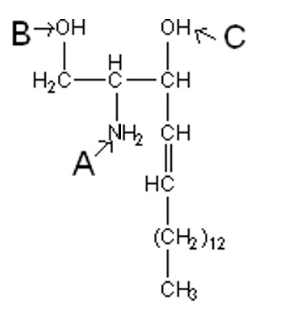 Which label points to the point of attachment for a fatty acid to yield a ceramide? | back 32 A |
front 33 Which of the following is an example of a heteropolysaccharide? | back 33 hyaluronic acid |
front 34 The bonding of alcohols to the anomeric center of a carbohydrate results in the formation of a(n) __________ bond. | back 34 glycosidic |
front 35  What is true concerning the polysaccharide shown above? | back 35 The branch point illustrated occurs more often in glycogen than it does in amylopectin. |
front 36 Which type of lipid-anchor is an isoprene-based lipid and connected to side-chain Cys residues? | back 36 Thioether-linked anchors |
front 37 The role of cartilage matrix proteoglycan is | back 37 to expel water upon compression and absorb water upon decompression. |
front 38 Which of the following structures is formed by fatty acids and other single tailed amphiphiles? | back 38 micelles |
front 39 Lipid bilayers with high concentrations of gangliosides are rare. Which of the following explanations is correct? A)The hydrophobic tails on gangliosides form a conical shape rather than a cylindrical shape making close packing difficult. B) Gangliosides contain trans fatty acids resulting in a bent hydrophobic tail making close packing difficult. D) None of the above is correct. E) Gangliosides contain large headgroups making close packing difficult. | back 39 Gangliosides contain large headgroups making close packing difficult. |
front 40 Which of the following modes of transport exhibits saturation, at very high solute concentration? | back 40 -Facilitated diffusion - Secondary active transport -Primary active transport -Ion channels |
front 41 All of the following describe the solid ordered (So) phase of a lipid bilayer EXCEPT: A) Tight packing B) Maximal bilayer thickness C) Found at temperatures below Tm D)Lipid chains likely to be bent | back 41 D) lipid chains likely to be bent |
front 42 ALL of the following are components of the cartilage matrix proteoglycan, EXCEPT: A) O-linked oligosaccharides, Not SelectedCorrect answer: B)Transmembrane domain C)Chondroitin sulfate D)N-linked oligosaccharides E)Keratan sulfate | back 42 B)Transmembrane domain |
front 43 All of the following are components of membranes EXCEPT: A)Triacylglycerols B) Proteins C) Sphingolipids D)Glycerophospholipids E) Cholesterol | back 43 Triacylglycerols |
front 44 A membrane surface protein with a keratan sulfate linkage is classified as a | back 44 Proteoglycan |
front 45 Which of the following amino acid residues is thermodynamically favored at the lipid-water interface of a membrane? | back 45 Tryptophan |
front 46 Proteins that bind to specific carbohydrates are called ______. | back 46 lectins |
front 47 Two of the following are linear polysaccharides made up of glucose
monomers: | back 47 cellulose, amylose |
front 48 Which carbon in D-glucose determines its D or L configuration? | back 48 C-5 |
front 49 Which of the following can be predicted using hydropathy plots? | back 49 Transmembrane alpha helices |
front 50 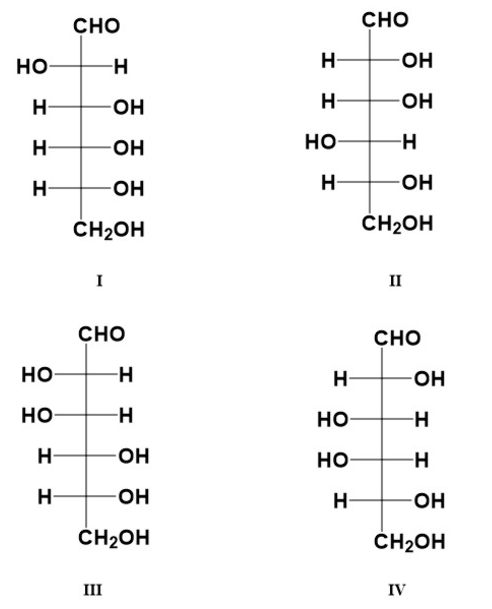 Which of the these is the C-2 epimer of D-glucose? Note that the identifying Roman Numeral is below each monosaccharide structure. | back 50 III |